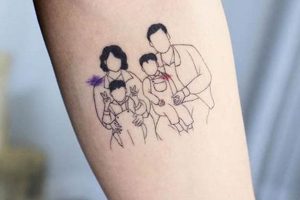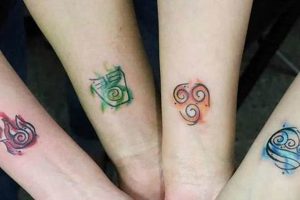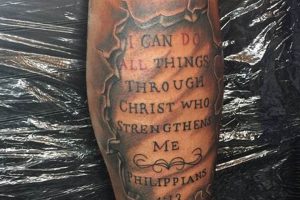Genealogical charts permanently inked onto the skin offer a powerful way to showcase heritage and familial connections. These designs can range from simple branching lines with names and dates to complex, artistic representations incorporating birthstones, portraits, national symbols, or other meaningful imagery. A minimalist design might feature a single tree with initials, while a more elaborate concept could involve intertwining branches with flowers representing each individual.
Such permanent displays of lineage serve as a constant reminder of one’s roots and provide a tangible link to ancestors. They can be a source of personal pride, a conversation starter, and a way to honor loved ones. Historically, body art has been used to signify clan membership and lineage in various cultures, demonstrating a long-standing human desire to express ancestral ties. This modern interpretation allows individuals to carry a piece of their history with them, fostering a sense of belonging and identity.
Exploring design options, placement considerations, artistic styles, and genealogical research techniques will further illuminate the process of creating a meaningful and personalized representation of heritage through body art.
Tips for Genealogical Body Art Designs
Careful planning ensures a meaningful and aesthetically pleasing representation of heritage. Consider these tips before committing to a permanent design.
Tip 1: Research Thoroughly. Accurate genealogical research forms the foundation of any meaningful design. Verify names, dates, and relationships to avoid perpetuating inaccuracies.
Tip 2: Choose a Style. Styles range from minimalist to ornate. Select a style that reflects personal aesthetics and accommodates the desired level of detail.
Tip 3: Consider Placement. The size and complexity of the design should complement the chosen body area. Larger designs might suit the back or chest, while smaller, simpler designs work well on wrists or ankles.
Tip 4: Incorporate Meaningful Symbols. Birthstones, national flags, or representative flowers can add depth and personalization.
Tip 5: Consult a Professional Artist. Experienced tattoo artists can provide valuable design input, ensuring technical accuracy and artistic integrity.
Tip 6: Reflect on Longevity. Consider how the design might age over time. Simple, bold lines tend to hold up better than intricate details.
Tip 7: Start Small. If uncertain about a large, complex piece, begin with a smaller element and expand later.
Thoughtful planning and collaboration with a skilled artist will result in a timeless piece of body art that honors heritage and celebrates familial connections.
By following these guidelines, individuals can ensure their genealogical body art becomes a cherished and meaningful expression of identity.
1. Ancestral Lineage
Ancestral lineage forms the foundation of genealogical tattoos, providing the informational framework upon which artistic expression builds. Understanding one’s family history is crucial for creating a meaningful and accurate representation. The depth of research influences design choices, impacting the level of detail and personalization.
- Direct Lineage Representation
This approach focuses on a direct line of descent, typically tracing back through parents and grandparents. Designs may feature a simple tree structure with names and dates, or a vertical list highlighting key ancestors. This method offers a clear, concise visualization of heritage. For example, a design could trace lineage back to a specific immigrant ancestor, highlighting their arrival date and country of origin.
- Broader Family Connections
Incorporating extended family, such as cousins, aunts, and uncles, creates a more complex and comprehensive representation. This approach allows for broader storytelling within the tattoo design. A circular design, for instance, might radiate outward from the individual, incorporating branches for each family line. This method can symbolize the interconnectedness of family.
- Cultural Heritage Integration
Ancestral origins often inform design choices. Incorporating cultural symbols, patterns, or motifs adds layers of meaning and reflects specific traditions. A tattoo might include Celtic knots to represent Irish heritage or a family crest derived from European ancestry. This integration adds depth and personalization.
- Generational Storytelling
Focusing on specific stories or significant events associated with ancestors adds a narrative dimension to the tattoo. This approach transforms the design from a simple lineage chart into a visual representation of family history. For instance, a tattoo might incorporate imagery representing an ancestor’s profession or a significant historical event they experienced. This adds a unique and personal touch.
These diverse approaches demonstrate how ancestral lineage informs and shapes genealogical tattoo designs. The depth of research, the breadth of family connections included, and the integration of cultural heritage all contribute to the final product, creating a personalized and meaningful representation of one’s roots.
2. Symbolic Imagery
Symbolic imagery enriches genealogical tattoos, transforming them from simple lineage charts into personalized narratives. These symbols add layers of meaning, representing family values, individual characteristics, shared experiences, or cultural heritage. Careful selection of symbols creates a visually compelling and deeply personal representation of one’s roots.
- Birthstones/Flowers
Incorporating birthstones or birth flowers representing family members adds a vibrant, personalized touch. Each stone or flower holds specific meanings, often associated with personality traits or symbolic significance. A ruby might represent passion for a fiery ancestor, while a forget-me-not could symbolize remembrance. This approach adds color and individual representation to the overall design.
- Animals/Mythical Creatures
Animals, chosen for their symbolic meanings, can represent family traits or values. A lion might signify strength and courage, while a wolf could symbolize loyalty and family bonds. Mythical creatures, like dragons or phoenixes, can represent resilience or transformation. These powerful symbols add a layer of mystique and cultural significance.
- Cultural/Religious Symbols
Cultural or religious symbols, such as Celtic knots, Hamsa hands, or crosses, reflect heritage and beliefs. These symbols often carry deep personal meaning and connect individuals to their ancestral traditions. Incorporating such symbols can add a sense of belonging and spiritual connection to the design.
- Objects/Hobbies
Representing shared hobbies or significant objects associated with ancestors adds a unique and personal touch. A musical instrument could symbolize a shared love of music, while a compass might represent a spirit of adventure. These symbols create a visual narrative, reflecting shared experiences and family history.
By incorporating symbolic imagery, individuals create genealogical tattoos that move beyond a simple record of lineage, becoming powerful expressions of personal and familial identity. These visual narratives celebrate heritage, honor ancestors, and communicate values, creating a lasting tribute to family history.
3. Artistic Style
Artistic style significantly impacts the visual representation of genealogical connections in tattoo form. The chosen style dictates the overall aesthetic, influencing the emotional impact and longevity of the design. Selecting a style that resonates with personal preferences and complements the chosen imagery is crucial for creating a meaningful and visually appealing piece.
- Minimalism
Minimalist designs emphasize simplicity and clean lines. Often featuring black ink and geometric shapes, this style prioritizes clarity and longevity. A minimalist family tree tattoo might consist of a simple, branching tree outline with names or initials subtly incorporated. This style is ideal for those seeking a discreet yet meaningful representation of lineage.
- Realism
Realistic depictions of portraits, objects, or scenes offer a detailed and personalized approach. This style requires a highly skilled artist to capture accurate likenesses and intricate details. A realistic family tree tattoo could incorporate portraits of ancestors alongside symbolic elements. This style allows for a powerful visual connection to one’s heritage.
- Watercolor
The watercolor style mimics the fluidity and vibrancy of watercolor paintings. Characterized by soft edges and blended colors, this style offers a more artistic and expressive representation. A watercolor family tree tattoo might feature a tree with branches rendered in flowing colors, representing different family lines. This style lends a sense of dynamism and artistic flair.
- Tribal/Traditional
Tribal and traditional styles often incorporate bold lines, geometric patterns, and symbolic imagery. These styles can effectively represent cultural heritage and ancestral connections. A tribal family tree tattoo might incorporate traditional motifs from a specific culture, interwoven with the tree design. This style offers a powerful visual representation of cultural identity and lineage.
The chosen artistic style significantly influences the final aesthetic and longevity of a family tree tattoo. Careful consideration of personal preferences, desired level of detail, and the symbolic meaning conveyed by each style ensures a tattoo that effectively communicates heritage and personal connection for years to come.
4. Placement on Body
Placement is a critical factor in the design and overall impact of genealogical tattoos. The chosen location influences visibility, size constraints, and how the design interacts with the body’s natural contours. Careful consideration of placement ensures the tattoo complements both the individual’s physique and the design’s narrative.
- Back/Chest
The back and chest offer large, relatively flat surfaces, accommodating expansive and intricate designs. These placements are ideal for complex family trees incorporating extensive details, portraits, or symbolic imagery. The expansive canvas allows for grand, visually striking representations of lineage, transforming the back or chest into a living tapestry of family history. However, these placements are less visible to the wearer on a daily basis.
- Arms/Legs
Arms and legs provide elongated canvases suitable for designs that flow with the body’s natural curves. These placements allow for designs that emphasize vertical or horizontal elements, such as cascading branches or a chronological timeline. A family tree winding around an arm or leg can symbolize the journey of lineage through time. Visibility varies depending on sleeve length or clothing choices.
- Wrists/Ankles
Wrists and ankles offer smaller, more intimate spaces for simpler designs. These placements are well-suited for minimalist trees, initials, or small symbolic elements. A small tree on the wrist can serve as a constant, personal reminder of familial connection. These locations are generally more visible, facilitating frequent personal reflection and readily sparking conversations.
- Ribcage/Side
The ribcage or side offers a unique canvas that conforms to the body’s curvature. This placement can be ideal for designs that emphasize personal connection and are less intended for public display. The proximity to the heart adds an element of intimacy and symbolism, representing the deep emotional connection to family. This location can be more sensitive for tattooing.
Ultimately, placement choices are deeply personal, reflecting individual preferences and the desired level of visibility. The chosen location significantly impacts the design’s overall aesthetic and how it interacts with the body, contributing to a meaningful and personalized representation of heritage.
5. Size and Complexity
Size and complexity are integral considerations in family tree tattoo design, directly influencing the visual impact, level of detail, placement options, and overall cost. The desired scope of the genealogical representation, ranging from a few key ancestors to a sprawling family history, dictates the necessary size and complexity of the design. A small, minimalist tree with a few names requires significantly less space and artistic detail than a large, intricate design incorporating portraits, symbols, and extensive text. This intricate design may necessitate a larger canvas like the back or chest, whereas the simpler design could comfortably fit on a wrist or ankle.
The level of detail incorporated also affects the complexity. A simple outline of a tree with names and dates represents a lower level of complexity compared to a design featuring photorealistic portraits of ancestors, intricate Celtic knotwork representing family bonds, and birth flowers signifying individual family members. This higher level of complexity demands more time and skill from the tattoo artist, impacting both the duration and cost of the tattooing process. For instance, a small, minimalist tree on the wrist might take a single session, while a full-back, highly detailed genealogical tapestry could require multiple sessions over several months.
Balancing size and complexity is crucial for achieving a successful and aesthetically pleasing result. Overly complex designs crammed into small spaces can appear cluttered and lose clarity, while simplistic designs on large canvases may lack visual impact. Careful planning and consultation with a skilled tattoo artist are essential for determining the appropriate size and complexity based on the desired genealogical scope, available body space, and budgetary constraints. This ensures the final design effectively communicates the intended narrative and remains visually appealing for years to come.
6. Color Palettes
Color palettes play a significant role in the overall aesthetic and symbolic meaning of family tree tattoos. Color choices can evoke specific emotions, represent family traits, or highlight cultural heritage. Careful selection of hues contributes to the visual impact and personal significance of the design, transforming a simple genealogical chart into a vibrant and expressive piece of art.
- Monochromatic
Monochromatic palettes, typically utilizing black ink, offer a classic and timeless aesthetic. This approach emphasizes the design’s structure and intricate details, creating a bold and enduring statement. Black ink also tends to age well, maintaining clarity over time. This palette is ideal for minimalist designs or those focusing on intricate linework and patterns, allowing the design’s form and composition to take center stage.
- Earthy Tones
Earthy tones, such as browns, greens, and muted yellows, evoke a sense of grounding and connection to nature. These colors can symbolize growth, stability, and family roots. Such palettes often complement designs incorporating natural elements like trees, leaves, or flowers, enhancing the symbolism of lineage and heritage. They can also create a sense of warmth and nostalgia, connecting the wearer to their ancestral past.
- Vibrant Colors
Vibrant colors, such as reds, blues, purples, and oranges, inject energy and personality into the design. These hues can represent individual characteristics, family stories, or cultural traditions. Bright colors might be used to represent birthstones, national flags, or symbolic flowers, adding layers of personal meaning. This approach creates a visually striking and emotionally resonant representation of family history.
- Aquarelle/Pastel
Aquarelle or pastel palettes create a soft, dreamlike aesthetic. These muted, blended colors evoke a sense of romance and nostalgia. This approach lends itself well to designs incorporating floral motifs, watercolor effects, or ethereal imagery. Pastel palettes can also soften the overall look of the tattoo, creating a more delicate and feminine aesthetic.
The chosen color palette significantly impacts the mood, symbolism, and overall aesthetic of a family tree tattoo. Careful consideration of color psychology, personal preferences, and the desired emotional impact ensures a design that resonates with the individual and effectively communicates their unique family narrative. Whether opting for the timeless elegance of monochromatic ink, the grounded warmth of earthy tones, the vibrant energy of bright colors, or the soft romance of pastels, the color palette is a powerful tool for enhancing the personal and artistic expression of genealogical heritage.
7. Incorporation of Text
Incorporation of text adds a layer of specificity and historical context to family tree tattoos, transforming them from visual representations into narrative-rich personal archives. Textual elements anchor the design, providing concrete details that connect the imagery to specific individuals and historical moments. Names, dates, locations, or meaningful quotes ground the symbolism within a tangible framework, allowing for clearer communication of lineage and family history. A tree design, for instance, gains deeper significance when names accompany each branch, clarifying relationships and individual identities. Including birth and death dates provides a temporal dimension, marking the passage of time and honoring ancestors’ lifespans. Similarly, adding locations of birth or significant family events roots the narrative within specific geographical contexts, connecting the family history to tangible places. Meaningful quotes, perhaps from a family member or reflecting a shared value, can further personalize the design and provide insight into familial beliefs and traditions.
The judicious use of text enhances clarity and provides opportunities for personalization. While names and dates offer essential information, the inclusion of short phrases or single words can add emotional depth and symbolic resonance. A single word like “Resilience” placed near a branch representing ancestors who overcame hardship imbues the design with powerful emotional weight and offers insight into family values. Similarly, incorporating a location like “Ellis Island” alongside an immigrant ancestor’s name adds historical context and speaks to the family’s journey. However, careful consideration of font, size, and placement is crucial for maintaining visual balance and legibility. Overly ornate fonts or excessive text can overwhelm the design, while poorly placed text can disrupt the visual flow and detract from the overall aesthetic.
Textual elements transform family tree tattoos into powerful storytelling mediums, bridging the gap between visual representation and historical narrative. The careful integration of names, dates, locations, and meaningful phrases adds depth, clarity, and personal significance. Thoughtful consideration of typography and placement ensures the text complements the overall design, creating a harmonious blend of imagery and information. This approach results in a visually compelling and historically grounded piece of body art that serves as a lasting tribute to family history and individual identity.
Frequently Asked Questions
Addressing common inquiries regarding genealogical body art provides clarity and facilitates informed decision-making. The following addresses key concerns and potential misconceptions.
Question 1: How much does a family tree tattoo typically cost?
Cost depends on factors like size, complexity, artist’s skill level, and geographical location. Small, simple designs may cost a few hundred dollars, while larger, more intricate pieces can cost thousands. Consulting multiple artists for quotes is recommended.
Question 2: How long does a family tree tattoo take to complete?
Completion time varies based on size, complexity, and individual pain tolerance. Small designs might take a single session of a few hours, while larger pieces can require multiple sessions spread over weeks or months.
Question 3: What are the best placement options for a family tree tattoo?
Optimal placement depends on design size and personal preference. The back and chest offer larger canvases for complex designs, while arms, legs, wrists, and ankles accommodate smaller pieces. Placement should complement the design and body contours.
Question 4: How can one ensure the accuracy of genealogical information in a tattoo?
Thorough genealogical research is crucial before committing to a design. Utilizing reputable resources like ancestry websites, historical records, and family documents verifies names, dates, and relationships, ensuring accuracy. Consulting with family members can also provide valuable information.
Question 5: Does a family tree tattoo need to include the entire family lineage?
Inclusion of the entire lineage is not required. Designs can focus on a direct line of descent, specific branches of the family, or key individuals of significance. Focusing on a smaller subset allows for more detailed representation within a manageable space.
Question 6: How does one choose the right tattoo artist for a family tree design?
Selecting an artist experienced in the desired style (e.g., realism, minimalism, watercolor) is crucial. Reviewing portfolios, seeking recommendations, and consulting with potential artists ensures compatibility with artistic vision and technical expertise.
Careful consideration of these frequently asked questions facilitates informed decisions, leading to a meaningful and aesthetically pleasing representation of heritage through body art.
Further exploration of specific design elements, artistic styles, and genealogical research techniques will provide additional guidance in creating a personalized and lasting tribute to family history.
Family Tree Tattoo Ideas
Exploration of genealogical body art reveals a powerful medium for expressing heritage and familial connections. Careful consideration of design elements, such as ancestral lineage, symbolic imagery, artistic style, placement, size and complexity, color palettes, and text incorporation, ensures a meaningful and personalized representation. Thorough genealogical research forms the foundation for accuracy, while collaboration with a skilled artist ensures technical expertise and artistic integrity. Addressing common concerns regarding cost, time commitment, and placement options facilitates informed decision-making.
Genealogical tattoos offer a tangible link to the past, celebrating ancestral legacies and fostering a deeper understanding of personal identity. These permanent expressions of heritage serve as a constant reminder of one’s roots, providing a source of connection and belonging for generations to come. Embarking on this journey requires thoughtful planning and reflection, transforming personal narratives into enduring works of art.







